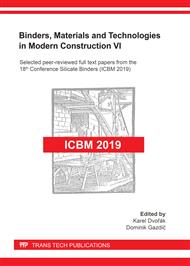p.59
p.65
p.73
p.83
p.89
p.97
p.105
p.113
p.119
Effect of Crystallization Additives on Durability of Cement Composites in Aggressive Environments
Abstract:
This article analyses the effect of crystallization additives on the long-term durability of self-compacting concretes (SCCs) in relation to specific types of chemically aggressive environments. The effect of both an inorganic acid solution and the aggressive solutions produced during plant ensilage were tested, while the effect of diesel on these modified concretes was also investigated. Attention was given to the effect of crystallization additives on the characteristically capillary porous structures of self-compacting concrete, specifically in terms of the long-term durability of SCCs in relation to the above-stated chemically aggressive solutions. The effect of aggressive environments was evaluated through a set of physical-mechanical trials and physical-chemical analyses.
Info:
Periodical:
Pages:
89-96
Citation:
Online since:
July 2021
Authors:
Keywords:
Price:
Сopyright:
© 2021 Trans Tech Publications Ltd. All Rights Reserved
Share:
Citation:


